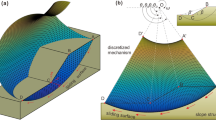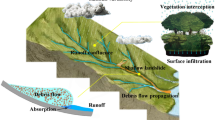Abstract
Creep is a flow type of mass movement that may proceed as slowly as a few millimeters per year; it therefore requires measurements taken over many years to calculate its velocity. Although soil creep occurs very slowly, it is a major contributor to river silt, and may also enhance landslides. This article discusses the rapid computation of creep velocity with the aid of dendrochronology. In the past few decades, dendrochronology has emerged as a branch of botany that may be utilized in various branches of science, including geomorphology. This is because it throws light on the conditions that prevailed during annual tree ring formation, and can help to determine the impacts of different parameters on tree ring formation; this knowledge may be used for a variety of purposes. The study reported here was carried out in the Nagribala Reserve Forest along the Abbottabad–Nathiagali Road, North Pakistan, on Pinus wallichiana (blue pine). Along with measuring the creep velocity, tree age and tree base height from the base of the slope were also studied to elucidate their influence on the creep velocity. The study revealed that a single slope may show different creep velocities in different portions of the slope, and that tree age has an inverse effect on creep velocity whereas tree base height from the base of the slope has little or no impact on it. The article also elaborates the afforestation history of the area and the possible contribution of this area to reservoir siltation.




Similar content being viewed by others
References
Ahmed M (1988) Population structure of some planted trees in Quetta. J Pure Appl Sci 7:25–29
Ahmed M, Sarangezai AM (1991) Dendrochronological approach to estimate age and growth rate of various species from Himalayan region of Pakistan. Pak J Bot 23:78–89
Ahmed M, Sarangezai AM (1992) Dendrochronological potential of a few tree species from the Himalayan region of Pakistan. J Pure Appl Sci 11:65–72
Ahmed M, Shaukat SS, Buzdar AA (1990a) Population structure and dynamics of Juniperus excelsa in Baluchistan Pakistan. Plant Ecol 1:271–276
Ahmed M, Nagi EE, Wang ELM (1990b) Present state of juniper in Rodhmallazi forest of Baluchistan Pakistan. Pak J For 40(3):227–236
Anderson SR, Aziz O, Tootle G, Mayer HG, Barnett A (2012a) Using Pacific Ocean climatic variability to improve hydrologic reconstructions. J Hydrol 434:69–77
Anderson SR, Tootle G, Mayer HG (2012b) Using Pacific Ocean climatic variability to improve hydrologic reconstructions of soil moisture for the upper Colorado river basin using tree-ring chronologies. J Am Water Resour Assoc 48(4):849-858
Backyardgardener, LLC (2015) Backyardgardener.com: Pinus wallichiana. Backyardgardener, LLC, Tacoma. http://www.backyardgardener.com/plantname/pda_a6a6.html. Accessed 31 Jan 2015
Bollati I, Seta MD, Pelfini M, Monte MD, Fredi P, Palmieri EL (2012) Dendrochronological and geomorphological investigations to assess water erosion and mass wasting processes in the Apennines of Southern Tuscany (Italy). Catena 90:1–17
Bollschweiler M, Stoffel M (2010) Variations in debris-flow occurrence in an Alpine catchment—a reconstruction based on tree rings. Global Planet Change 73:186–192
Bollschweiler M, Stoffel M, Melanie Ehmisch-Feick, Monbaron M (2007) Reconstructing spatio-temporal patterns of debris-flow activity using dendrogeomorphological methods. Geomorphology 87:337–351
Bollschweiler M, Stoffel MY, Scheuwly D (2008) Dynamics in debris-flow activity on a forested cone—a case study using different dedroecological approaches. Catena 72:67–78
Bollschweiler M, Corona C, Stoffel M (2013) How to improve dating quality and reduce noise in tree-ring based debris-flow reconstructions. Quat Geochronol 18:110–118
Brubaker LB (1987) Forest disturbance and tree-ring analysis. In: Jacoby GC, Hornbeck JW (eds) Proceedings of the International Symposium on Ecological Aspects of Tree-ring Analysis, 17–21 Aug. 1986, Tarrytown, N.Y. US Department of Energy, Washington, DC, pp 101–118
Cánovas JAB, Bodoque JM, Lucía A, Martín-Duque JF, Díez-Herrero A, Ruiz-Villanueva V, Rubiales JM, Genova M (2013) Dendrogeomorphology in badlands: methods, case studies and prospects. Catena 106:113–122
Cook ER (1987) The decomposition of tree-ring series for environmental studies. Tree Ring Bull 47:37–59
Corominas J, Moya J (2010) Contribution of dendrochronology to the determination of magnitude–frequency relationships for landslides. Geomorphology 124:137–149
Corona C, Trappmann D, Stoffel M (2013) Parameterization of rockfall source areas and magnitudes with ecological recorders: when disturbances in trees serve the calibration and validation of simulation runs. Geomorphology 202:33–42
Crow P (2005) The influence of soils and species on tree root depth (information note). Forestry Commission, Edinburgh
Eckstein D, Aniol RW, Bauch J (1983) Dendroklimatologische Untersuchungen zum Tannensterben. Eur J For Pathol 13:279–288
Engineeringtoolbox.com (2015) Earth or soil—weight and composition. http://www.engineeringtoolbox.com/earth-soil-weight-d_1349.html. Accessed 31 Jan 2015
Fritts HC (1976) Tree rings and climate. Academic, London
Garland NA, Grissino-Mayer HD, Deagan K, Harley GL, Waters G (2012) Dendrochronological dating of wood from the Fountain of Youth Park Archaeological Site (8SJ31), St. Augustine, Florida USA. Tree Ring Res 68(1):69–78
Google Inc. (2015) https://www.google.com/maps/@34.0716418,73.3623011,6317m/data=!3m1!1e3. Accessed 31 Jan 2015
Jacoby GC, Ulan LD (1983) Tree ring indications of uplift at icy caps, Alaska, related to 1899 earthquakes. J Geophys Res 88:9305–9313
Khan AH (1968) Ecopathological observations in Trakhal Forest with special reference to damage by Fomes pini. Part I: Regeneration status of the forest. Pak J For 18:169–228
Meko DM, Therrell MD, Baisan CH et al (2001) Sacramento river flow reconstructed to AD 869 from tree rings. J Am Water Resour Assoc 37(4):1029–1039
Orwa C, Mutua A, Kindt R, Jamnadass R, Anthony S (2009) Agroforestree database: a tree reference and selection guide, version 4.0. World Agroforestry Centre, Nairobi. http://www.worldagroforestry.org/sites/treedbs/treedatabases.asp. Accessed 31 Jan 2015
Perez-Valdivia C, Sauchyn D (2011) Tree-ring reconstruction of groundwater levels in Alberta, Canada: long term hydroclimatic variability. Dendrochronologia 29:41–47
Sabir MA, Rehman SS, Umar M, Waseem A, Farooq M, Khan AR (2013) The impacts of suspended sediment load on reservoir siltation and energy production: a case study of Indus River and its tributaries, Khyber Pakhtunkhawa Pakistan. Pol J Environ Stud 22(1):219–225
Sabir MA, Rehman SS, Umar M, Waseem A, Farooq M, Fariduulah and Irshad M (2014) Assessment of hydro power potential of Swat, Kohistan Himalayas: a solution for energy shortfall in region. Water Res 41(5):612–618
Saez JL, Corona C, Stoffel M, Schoeneich P, Berger F (2012) Probability maps of landslide reactivation derived from tree-ring records: Pra Bellon landslide, southern French Alps. Geomorphology 138:189–202
Saez JL, Corona C, Stoffel M, Berger F (2013) High-resolution fingerprints of past landsliding and spatially explicit, probabilistic assessment of future reactivations: Aiguettes landslide, Southeastern French Alps. Tectonophysics 602:355–369
Saito M (1969) Forecasting time of slope failure by tertiary creep. In: Proc 7th Int Conf on Soil Mechanics and Foundation Engineering, Mexico City, Mexico, 29 Aug 1969, 2:677–683
Schweingruber FH, Fritts HC, Bräker OU, Drew LG, Schär E (1978) Dendroclimatic studies on conifers from central Europe and Great Britain. Tree Ring Bull 38:61–91
Seta MD, Monte MD, Fredi P, Palmieri EL (2009) Space–time variability of denudation rates at the catchment and hillslope scales on the Tyrrhenian side of Central Italy. Geomorphology 107:161–177
Sheikh MI (1985) Afforestation in juniper forests of Baluchistan. Pakistan Forest Institute, Peshawar, p 46
Shroder JF Jr (1980) Dendrogeomorphology: review and new techniques of tree-ring dating. Prog Phys Geogr 4:161–188
Siddiqui MF, Ahmed M, Shaukat SS, Khan N, Khan IA (2013) Age and growth rates of dominant conifers from moist temperate areas of southern Himalayan and Hindukush region of Pakistan: evaluating the possible role of environmental characteristics. Pak J Bot 45(4):1135–1147
Šilhán K, Pánek T, Hradecký J (2013) Tree-ring analysis in the reconstruction of slope instabilities associated with earthquakes and precipitation (the Crimean Mountains, Ukraine). Geomorphology 173:174–184
Stoffel M (2010) Magnitude–frequency relationships of debris flows—a case study based on field surveys and tree-ring records. Geomorphology 116:67–76
Stoffel M, Butler DR, Corona C (2013) Mass movements and tree rings: a guide to dendrogeomorphic field sampling and dating. Geomorphology 200:106–120
Thompson GR, Turk J (1998) Introduction to Physical Geology. Saunders College Pub, USA
Umar M, Betts P, Khan MMS, Sabir MA, Farooq M, Zeb A, Jadoon UK, Ali S (2015) Signatures of Late Neoproterozoic Gondwana assembly and Maronian glaciation in Lesser Himalaya: a palaeogeographical and stratigraphical approach. Acta Geol Pol 1:1–9
Wiles GC, Calkin PE, Jacoby GC (1996) Tree-ring analysis and Quaternary geology: principles and recent applications. Geomorphology 16:259–272
Wistuba M, Malik I, Gärtner H, Kojs P, Owczarek P (2013) Application of eccentric growth of trees as a tool for landslide analyses: the example of Picea abies Karst. in the Carpathian and Sudeten Mountains (Central Europe). Catena 111:41–55
Author information
Authors and Affiliations
Corresponding author
Rights and permissions
About this article
Cite this article
Sabir, M.A., Umar, M., Farooq, M. et al. Computing soil creep velocity using dendrochronology. Bull Eng Geol Environ 75, 1761–1768 (2016). https://doi.org/10.1007/s10064-015-0838-2
Received:
Accepted:
Published:
Issue Date:
DOI: https://doi.org/10.1007/s10064-015-0838-2




